There is no second thought on accepting customer service as the key to customer loyalty and business growth. A good customer experience encourages 75% of consumers to spend more, while a bad customer experience causes 78% of customers to back out of the purchase (source).
Top-notch customer service is essential for all business types. However, in a digitalized marketplace, there is no one-size-fits-all approach. There are now many types of customer service to fulfill the needs of different customers.
The challenge is choosing the right type of customer service for your business. Your customer service approach should increase customer satisfaction without burdening your resources. This guide is designed to address this.
In this guide, I’ll discuss the top 12 types of customer service in detail and help you choose the right type for your business. So, let’s get started.
Defining customer service and its importance
Customer service involves assisting customers before, during, and after purchasing a product. The goal is to ensure that customers have a positive experience at all stages of their interaction with the brand, including product research, purchase, and usage.
To better understand, let’s look at the example of Temu, the renowned ecommerce giant. It offers exceptional customer service to users through its 24/7 live chatbot. Its live chatbot helps answer general questions, handles order-related queries, and manages returns and refunds in a highly responsive and professional way.
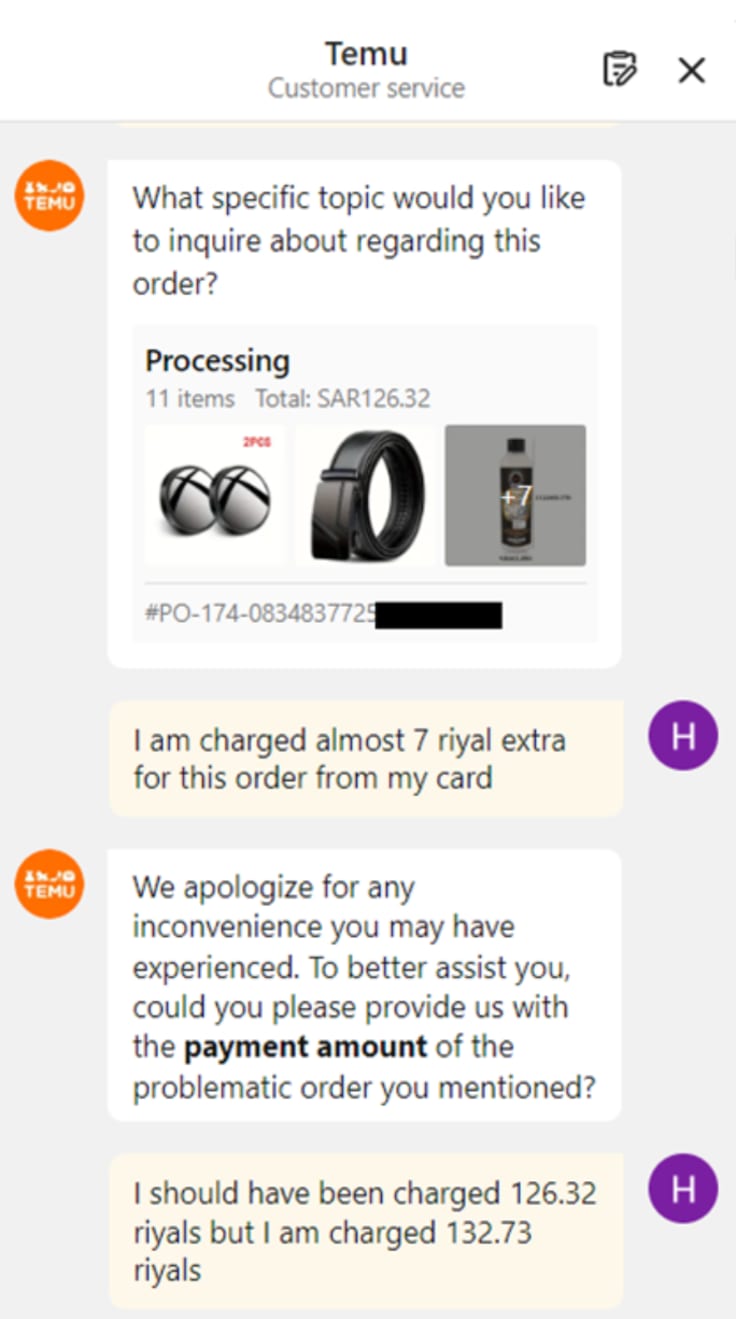
The key benefits of customer service
Customer service is an essential element for 96% of consumers in brand loyalty (source). It helps in many aspects, such as:
-
improving customer experience and satisfaction,
-
increasing customer retention/loyalty,
-
increasing repeat purchases,
-
exploring word-of-mouth marketing,
-
giving a competitive edge,
-
getting positive reviews,
-
improving product upselling,
-
improving brand reputation and trust.
Outstanding customer service can significantly impact your business. Customer service teams are responsible for providing users with the best experience possible. They’re trained to work effectively to ensure that companies offer excellent customer service.
Do you want to learn more about good customer service? We have something special for you. 🤝 Take our course "The Essentials of Customer Support" and create the best customer service teams! 🚀
Role of customer service representatives in customer satisfaction
Customer service representatives (CSRs) are the key to customer satisfaction. Since they interact with customers, they must feel valued and heard with every interaction. Good CSRs guarantee top-notch service, which is why business owners set specific qualities for CSR applicants.
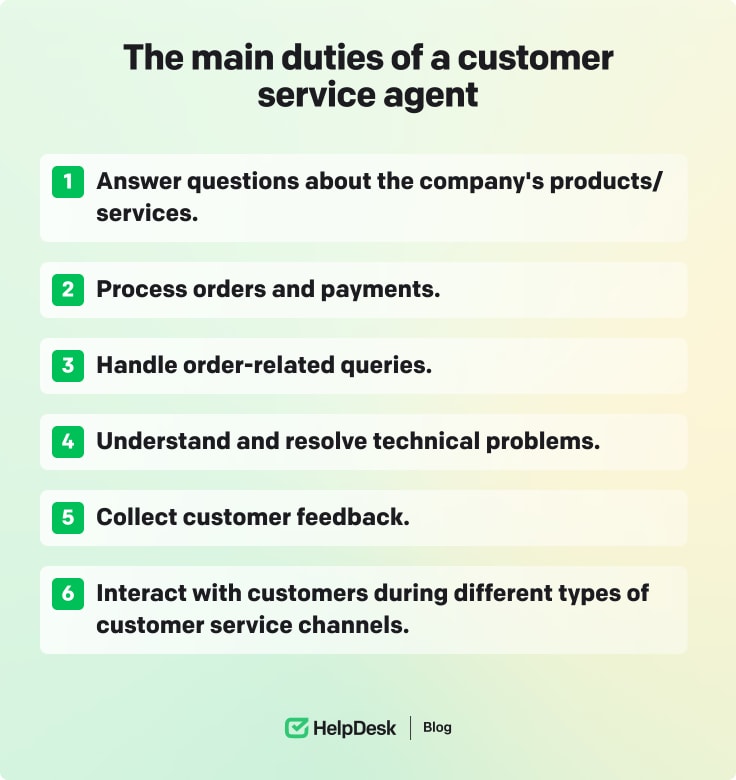
A customer service representative needs a good balance of technical and soft skills to proactively perform daily customer service management tasks and memorably interact with customers. They should be able to understand the technical complications the customer is sharing and then assist them with the proper fixes in a friendly and professional manner.
Types of customer service
Due to digitalization and technological advancements, customer service has evolved into various types. Let’s explore the top 12 types of customer service and understand the scenarios in which they’re best suited.
1. Traditional walk-in customer service
Walk-in customer service is all about creating genuine connections with our valued customers in person. It’s a timeless approach that continues to hold its significance.
When customers step into the service area, they’re welcomed with a personal and warm touch. Whether they have questions, need to file a complaint, or want to return a product, the support team is there to provide the best assistance. While digital methods are gaining traction, there’s something special about the traditional charm of walk-in customer service that some people still prefer.
The beauty of walk-in customer service lies in the confidence it instills in our customers, knowing that their concerns are being addressed face-to-face. It also allows the dedicated team to delve deeper into conversations and provide exceptionally satisfying support.
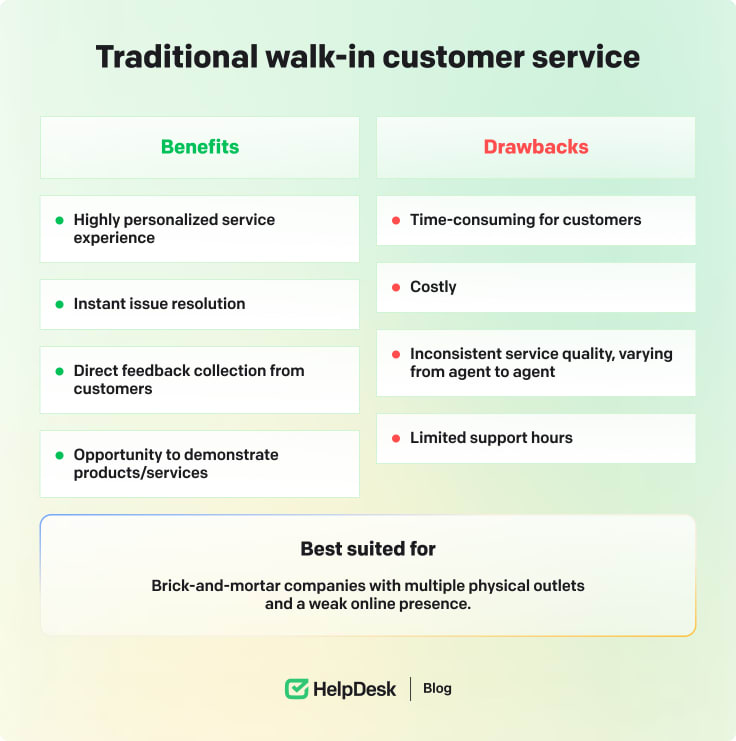
2. Phone support
Phone support is one of the most popular types of customer service. It involves speaking to a real person over the phone. The customer service representative and the customer have verbal conversations through voice calls via mobile phones, landlines, or other applications.
Nearly 65% of potential customers interact with brands by phone (source). Furthermore, 76% of customers prefer issue resolution through the phone (source). During a phone call, customers can explain their issues better and get instant responses to their queries. It provides a human touch and allows agents to assess customer problems and emotions.

3. Email support
Email support involves providing customers with a way to contact the company through email. It’s famous for customers who prefer to document their problems in writing and attach relevant files.
Email support is mobile-friendly and helps document the details correctly. Customers can explain the issue thoroughly and share the necessary files. Over 40% of customers use email for issue resolution (source). Similarly, customer service reps can adequately understand the customer’s issue before replying. They can offer consistent quality support using predefined responses for common queries.
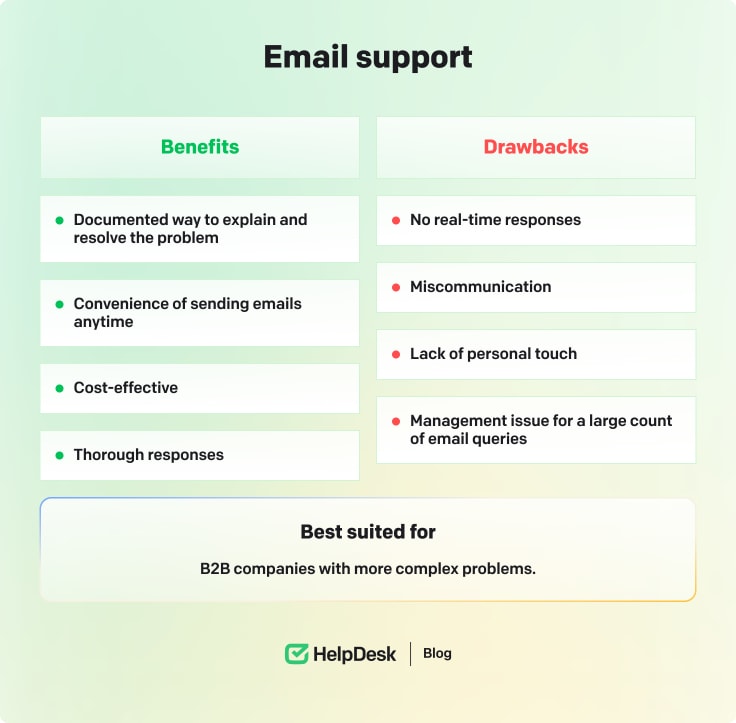
4. Self-service customer support
Self-service customer support involves providing customers with access to information and solutions through a knowledge base or online platform. The digital era has shifted the mindset of customers to get everything instantly by pressing a few clicks.
67% of customers like to use some form of self-service instead of interacting with customer service agents (source). According to another study, 81% of customers try to resolve the issue independently before reaching the service representative (source). That’s why self-service is becoming one of the popular types of customer service.
Self-service customer service also frees customer support teams from repetitive FAQ queries and lets them focus on more complex issues. Although it’s a low-cost and convenient way to provide customer support, it requires regular maintenance and updates.

5. Live chat customer service
Live chat customer service involves providing customers real-time support through a chat platform. In this type of customer service, the support agent interacts with customers through live back-and-forth chats.
Today, 41% of customers prefer live chat customer service over other ways, like phone support or email (source). Moreover, 85% of customers feel satisfied using live chat (source). Instead of having costly phone calls or waiting long to get email replies, live chat offers instant digital interaction with customer service representatives.
Live chat also facilitates customer service agents. They can communicate with multiple customers simultaneously and use standard scripts to answer common queries.
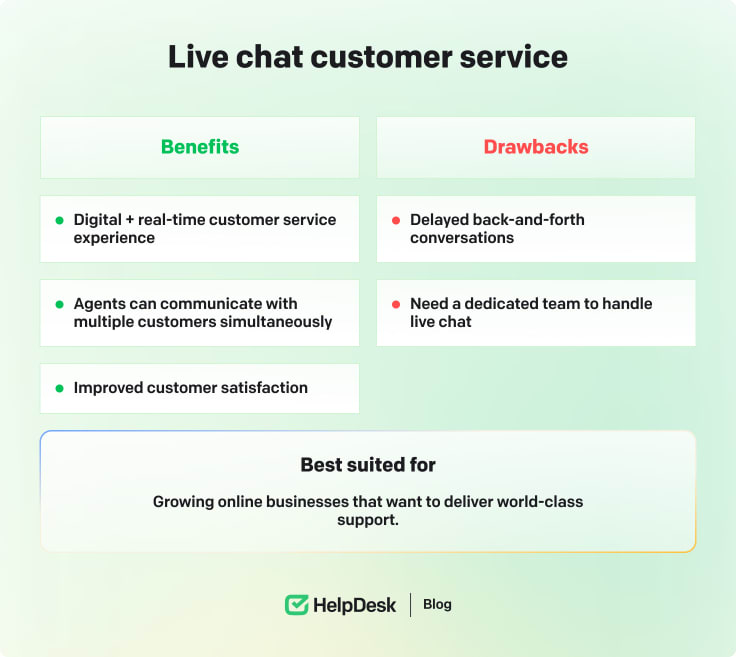
6. Chatbots customer service
Chatbots are also one of the emerging types of customer service. They’re automated virtual assistants that provide customers with instant support. Simply put, they’re the advanced form of live chat customer service.
Chatbots are virtual customer service representatives trained in your company’s knowledge base and available 24/7 to answer customer queries. When a customer asks a question, the chatbot quickly finds the best-matched response and sends it to the customer, allowing instant responses within seconds.
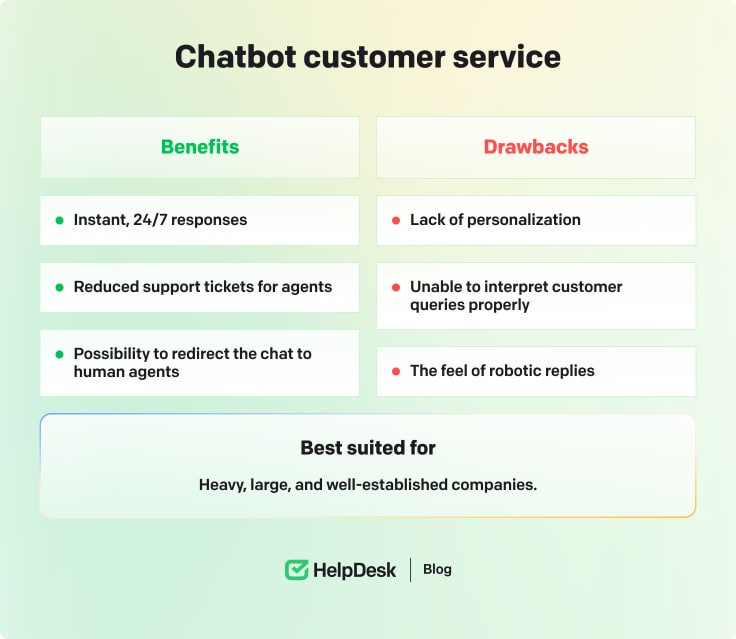
7. Social media customer service
Social media customer service involves providing support to customers through social media platforms. As businesses increasingly rely on social media presence, the use of these platforms for customer service is also growing.
When customers find your brand through social media platforms, they want to interact with you directly from that platform. For example, you operate a clothing brand with an active Instagram page. Customers who find you there intend to send you direct messages instead of calling, emailing, or visiting your website.
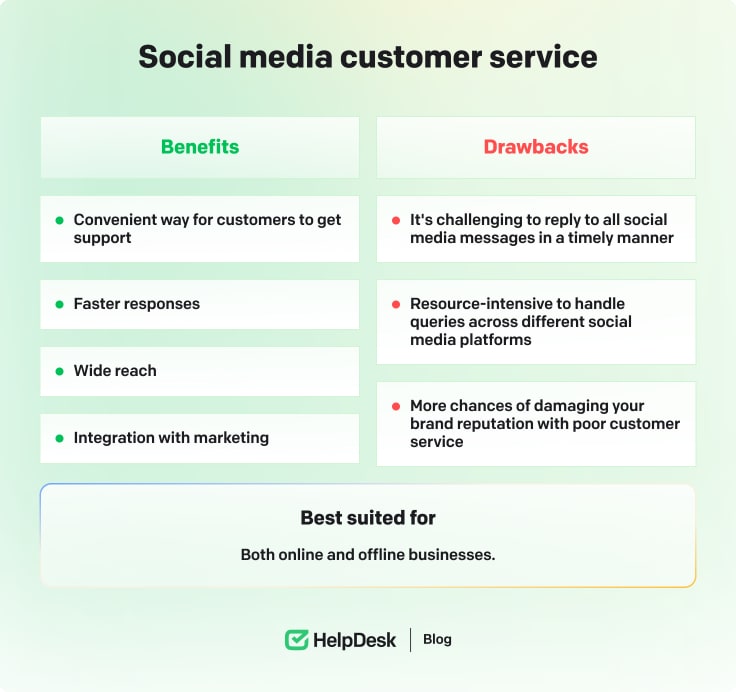
8. Interactive voice response (IVR) customer service
Interactive voice response (IVR) is an automated phone system that provides customers with pre-recorded answers for fundamental issues. IVR is usually the first point of contact when a customer uses phone support. It presents an automated menu to direct the customer to the right option or agent.
IVR can provide a prerecorded answer to fundamental issues and the option to transfer the call to the customer service agent. For example, if a customer calls a bank to check their account balance, the IVR system can guide them through retrieving this information without speaking to a live representative. This requires pressing the right buttons as instructed by the IVR.
IVR is a cost-effective way to provide customer support but requires careful design to avoid customer frustration.
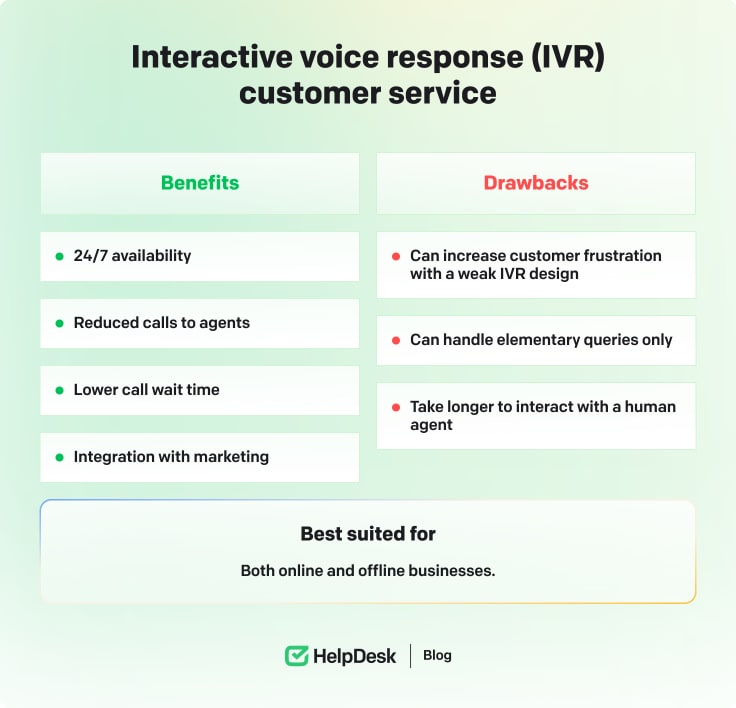
9. On-site customer service
On-site customer service involves providing customers with support in person at their location.
On-site customer service is needed for technical activities involving installation, maintenance, and repairs. For example, if a customer purchases a home security system, an on-site technician might visit their home to install the system. Moreover, the on-site customer service team must be technically and verbally skilled to offer customers a satisfactory experience.
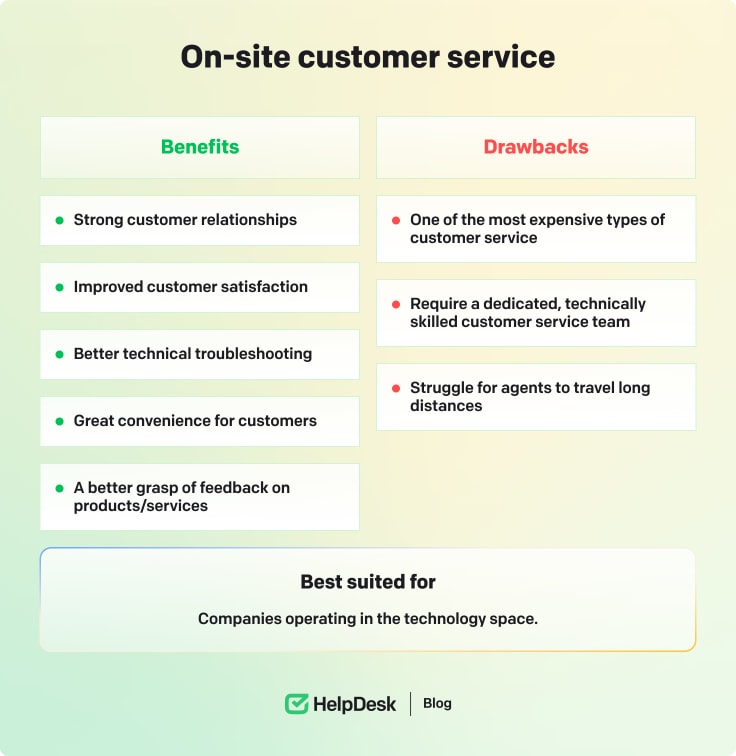
10. Customer-focused communities and forums
Creating customer-focused communities and forums involves developing online platforms where customers can share ideas and feedback. This unique customer service encourages customers to discuss their experiences with your products/services, ask questions, and help each other.
Establishing customer-focused communities and forums is an excellent way to utilize customer resources and cultivate a loyal community. Your customers become voluntary customer service representatives, guiding other customers with their issues. Additionally, this platform provides an ideal space for gathering customer feedback and insights. However, it’s important to note that building and maintaining such communities and forums takes time.

11. Omnichannel support
Omnichannel support connects conversations from channel to channel without losing context. Simply put, a single platform aligns all customer conversations across all communication channels. For example, suppose a customer begins a conversation on social media and follows up through email or live chat. In that case, the customer service reps can see all the past discussions through a central platform.
With omnichannel customer service, businesses can provide a seamless customer experience across all touchpoints.

12. AI-powered support
With the rapid advancements in AI, support powered by is also emerging as a modernized type of customer service. It uses automation and machine learning to serve customers better.
The best example is AI-powered chatbots that can carry out human-like conversations with natural language processing (NLP). These chatbots can handle queries, help place orders, process transactions, and handle returns. In addition to chatbots, you can find AI in action for automating repetitive tasks, like follow-up emails, feedback collection, and more.
Check out HelpDesk and its AI tools in the ticketing system to discover more about powerful AI features. 🤖

Choosing the right customer service type
Given the range of customer service options available, it’s understandable to feel overwhelmed when deciding which type to choose.
4 Key Factors to Consider
1. Age group
The age group of your customer base is an essential factor to consider when selecting the best customer service for your business. A younger customer base prefers using digital customer service methods, like chatbots, email, social media, etc. In contrast, the older customer base prefers traditional phone calls or walk-in customer support.
First, analyze your customers’ age demographics and preferred customer service channels. Then, decide which customer service type to use. You may even have to integrate two or more customer service types to address different age groups.
2. Size of the customer support team
The size of your customer support team also plays a crucial role in deciding which customer service approach works for you. Some customer service types, such as phone, on-site, email, and live chat, require a large support team to ensure quality services. In contrast, chatbots, AI-powered support, and communities/forums require a small support team.
Evaluate your customer support team size and pick an exemplary customer service type.
3. Industry
The industry you work in also influences what customer service works best. For example, ecommerce and retail businesses can find live chat, chatbots, ecommerce help desks, and social media useful, while IT companies find on-site support necessary.
The recommended approach is to look at what types of customer service your competitors offer in your industry and then decide accordingly.
4. General market trends
New technologies can quickly change market trends. The best example is ChatGPT. Since its release, there has been a new wave of AI chatbots for customer service. Therefore, you should look into the market trends around customer service for your business type and then decide which one aligns with customer needs and keeps you competitive.
Summary
Today, 88% of customers believe that the experience they receive from a company is equally important as its products (source). Good customer service is now directly linked to business growth and customer satisfaction/retention.
That’s why you should ensure your business leverages suitable customer service types. However, evaluate your customer needs and choose the best customer service types that suit your business model.



